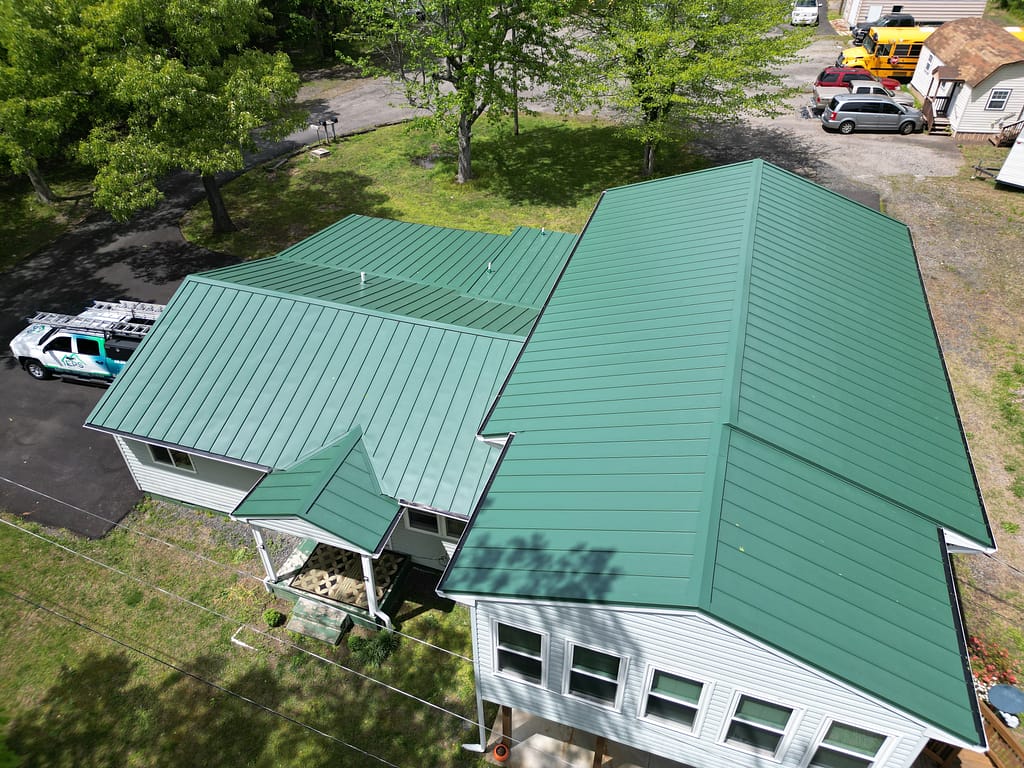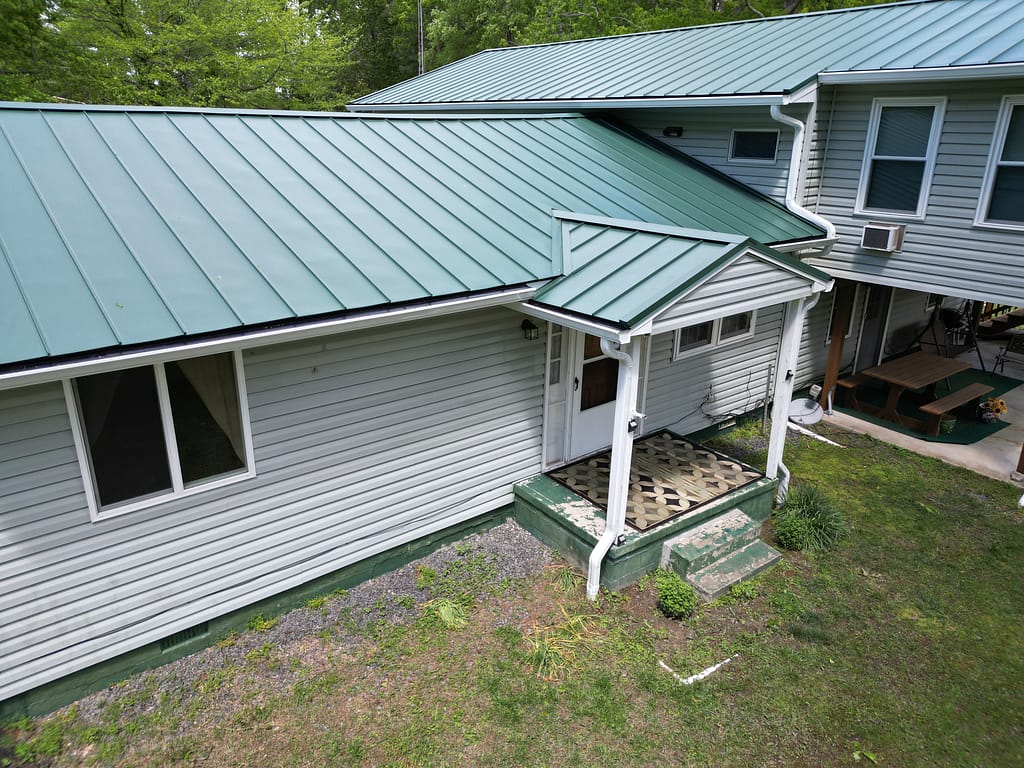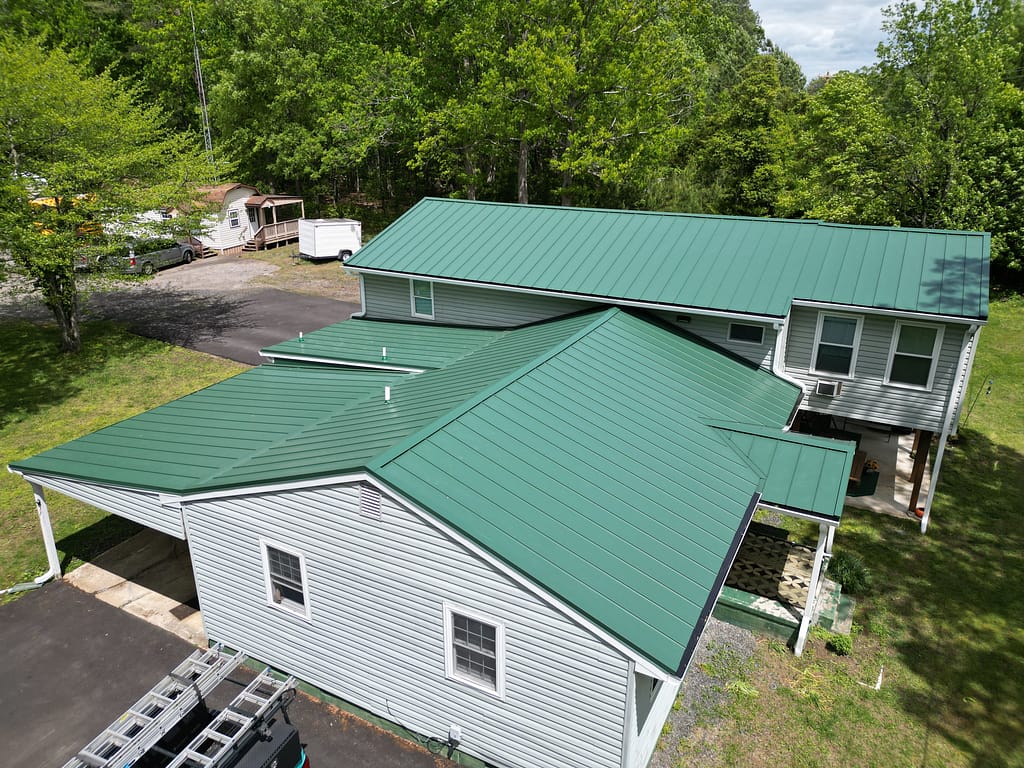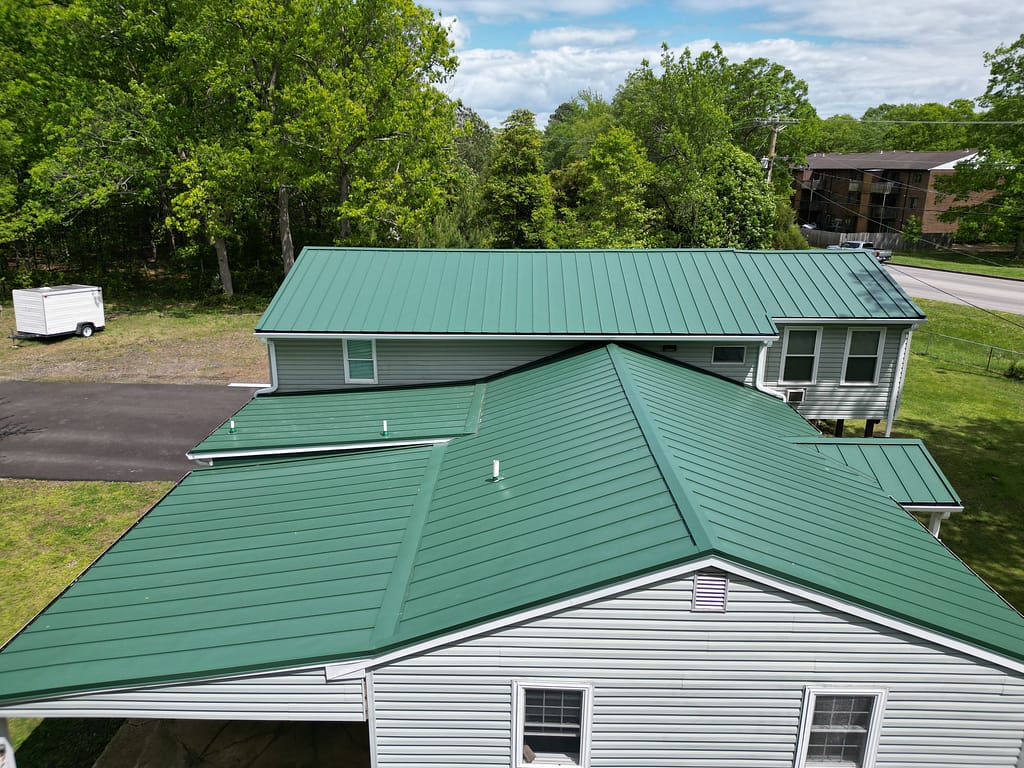Maximizing Durability with Top Standing Seam Roofs
Key Takeaways
Standing seam metal roofs offer a range of benefits including durability, energy efficiency, and weather resistance, with various material options and system types to suit different aesthetic preferences and budgets.
The distinctive construction of standing seam roofs with concealed fasteners and raised interlocking panels contributes to their functionality, while the selection of materials like aluminum, steel, copper, or zinc provides options for corrosion resistance and aesthetic appeal.
While standing seam metal roofs have a higher initial cost and can be more expensive in terms of installation and materials, they typically offer longevity, requiring minimal maintenance and making them a cost-effective solution over time.



Understanding Standing Seam Roofs
Standing seam metal roofs, as the name suggests, are characterized by the raised interlocking metal panels that run vertically along the roof. The unique design offers a contemporary and aesthetically pleasing look, thanks to the distinct vertical legs creating a beautiful shadow effect and the illusion of a flat pan between major ribs. But the beauty isn’t just skin-deep; these standing seam roofing systems are incredibly functional too. The standing seam panels, also known as standing seam metal panels, are attached using concealed fasteners, which distinguishes them from other roofing types that often have exposed fastening systems. This is what makes the standing seam roof system so effective and popular among homeowners and builders alike.
Their versatility does not end there. These roofs are not a one-size-fits-all solution. With a myriad of panel types and system variations, they can be installed in various areas of your home such as front porches, side porches, and bay windows to enhance your home’s curb appeal. Essentially, a standing seam metal roof offers you the freedom to craft a unique look for your home while providing top-notch protection against the elements.
Components of a Standing Seam Roof
More than just visible metal panels, the standing seam metal roof includes various additional features and benefits. Functioning as a comprehensive system, each component contributes significantly to its durability and functionality. The foundation of these roofs is the roof decking, typically made from plywood or OSB, which supports all other roofing components. Over this, a high-heat ice and water shield underlayment is applied to enhance protection from water-related damage.
Metal panels stand as the primary exterior element of the roof. These panels are attached to the lock strip at the rake edge using a locking mechanism and fastened using clips. The standing seam metal roofing panels are uniquely attached using concealed fasteners that allow for natural thermal movement.
Additional components like lock strips, Z bar flashings, and ridge caps all play their part in ensuring the roof’s durability and weather resistance. Overall, the intricate design and interaction of these components contribute to the superior performance of standing seam metal roofs.
Types of Standing Seam Roofs
Not all standing seam metal roofs are identical. Three main classifications exist for these roofs:
Snap-lock systems: These feature concealed fasteners with male and female legs that snap together for simple installation of snap lock panels.
Mechanical lock systems: These require a powered seaming machine to engage the panels.
Batten seam systems: These use vertical battens to secure the panels in place.
The standing seam panels themselves can also vary. They can be symmetrical or asymmetrical. Symmetrical panels are identical on both sides, allowing for ease of installation and repair, whereas asymmetrical panels must be installed in sequence. Your choice between these types can also have economic implications, with fastening flange panels being more budget-friendly but less suited for projects requiring weathertight warranties.
The takeaway? Understanding the types of standing seam roofs can help you make an informed decision that suits both your aesthetic preference and budget.
Advantages of Standing Seam Metal Roofs


What makes standing seam metal roofs increasingly popular? The answer lies in their numerous advantages. These roofs offer a distinctive look that can complement a wide variety of home styles. And with a selection of over 100 colors, you’re sure to find one that matches your home perfectly.
But the appeal of standing seam metal roofs isn’t just aesthetic. Their functional benefits, such as superior durability, weather resistance, and energy efficiency, are equally significant. Let’s delve deeper into these advantages.
Durability and Longevity
Their impressive lifespan is one standout advantage of standing seam metal roofs. With warranties typically covering at least 30 years and the actual panels often lasting at least 50 years, these roofs far exceed the 15 to 20 years life expectancy of asphalt shingle roofs. Certain premium metals like aluminum and copper offer natural rust resistance, directly contributing to their longevity and minimal maintenance requirements.
However, it’s not just about the materials. The lifespan and overall durability of a standing seam metal roof are greatly enhanced when the installation is performed by professional installers. This assures the roof’s potential to reach or exceed its expected longevity. Despite a higher upfront cost compared to traditional roofing options, a standing seam metal roof is viewed as a long-term investment. It requires minimal maintenance or repairs, providing significant cost savings over the roof’s lifespan.
Weather Resistance
Imagine a roof capable of withstanding wind speeds that exceed the usual in hurricane-prone regions. That’s the impressive weather resistance offered by standing seam metal roofs. This superior wind uplift resistance is due to design considerations such as:
Closer purlin spacing
Thicker decking
Mechanically seamed panels
Narrower, heavier gauge metals
But it’s not just about wind. Standing seam metal roofs also demonstrate high resistance to hail, with materials like 24-gauge metal offering increased protection. Even when hail causes cosmetic damage, the structural integrity and weathertightness of these roofs typically remain unaffected.
And let’s not forget about snow. The benefits of these roofs in snowy conditions include:
Strong vertical seams, durable panels, and smooth roofing surfaces facilitate snow shedding and provide increased snow load support.
Proper insulation and ventilation help prevent ice dam formation.
Snow guards and snow fences help manage snow release to safeguard pedestrians and property.
With these enhancements, these roofs are well-equipped to handle snowy conditions.
Energy Efficiency
Beyond durability and weather resistance, standing seam metal roofs offer several benefits, including:
High thermal emittance, allowing them to release absorbed heat efficiently
High reflectivity, capable of reflecting up to 70% of the sun’s energy back into the atmosphere
Cooler home during the warm months
Significant savings on energy costs
Certain types of metal, like aluminum and copper, can further enhance energy efficiency. Aluminum roofing, for instance, does not absorb as much heat as steel and cools down more rapidly, potentially reducing a home’s heating and cooling costs by 20%. Copper roofs, with their natural ability to absorb and radiate less heat, deflect sunlight and save on energy bills through their innate reflective properties.
Undoubtedly, standing seam metal roofs are an eco-friendly choice, offering benefits to both the environment and your finances.
Energy Efficiency
Despite the numerous advantages of standing seam metal roofs, potential drawbacks must also be taken into account. The most significant concern for many homeowners is the cost. Standing seam metal roofs are approximately three times more expensive than architectural asphalt shingles. The cost per square foot can reach around $15.00, which is substantially higher than the approximate cost of $4.76 per square foot for asphalt shingles.
Another possible drawback is noise. During rainstorms, metal roofs can produce noise, although this is generally undetectable to most humans as they cannot distinguish between sounds less than eight decibels apart. However, this can be mitigated with proper insulation and a solid roof deck.
It’s important to balance these disadvantages against the numerous benefits when contemplating a standing seam metal roof.
Initial Cost
Compared to traditional roofing materials, the initial cost for a standing seam metal roof is higher. The national average cost is $29,000, but it can range from $18,000 to $41,000 depending on various factors. Costs per square foot generally range from $5 to $26, influenced by the choice between affordable and high-end metal materials.
The size of the roof and the specific types of metal roof panels chosen are primary factors that influence the overall cost. Additionally, the removal and disposal of old roofing materials can cost between $1 to $5 per square foot, adding to the total expense of the installation.
While the initial cost may seem high, it’s important to consider it as a long-term investment, with the roof’s longevity and minimal maintenance providing significant cost savings over time.
Noise
One potential drawback of standing seam metal roofs, despite their numerous benefits, is the noise they can produce during rainstorms. However, the noise difference between metal roofs and shingle roofs is generally undetectable to most humans as they cannot distinguish between sounds less than eight decibels apart.
There are also solutions to mitigate this issue. For instance, installing metal panels over existing shingles can help reduce noise levels, as the shingles provide additional insulation. Additionally, noise during rainstorms on steel roofs can be mitigated with the use of proper insulation and solid decking. Even copper roofs, which don’t buffer noise as well as other materials, can benefit from modern underlayments used during installation to aid in noise reduction. Some solutions to consider include:
Installing metal panels over existing shingles
Using proper insulation and solid decking for steel roofs
Using modern underlayments during installation for copper roofs
These solutions can help reduce noise levels and create a quieter environment.
Material Options for Standing Seam Metal Roofs
Choosing the material is one of the key decisions you’ll face when considering a standing seam metal roof. Each material option offers unique benefits and comes with its own cost. Some options to consider are:
Steel: the most cost-effective material for standing seam metal roofs
Copper: the most expensive option, but offers a unique and attractive appearance
Zinc: a premium metal option with a distinctive look
Aluminum: a lightweight and durable choice
Consider your budget and desired aesthetic when choosing the material for your standing seam metal roof.
You’ll also have various customization options to choose from for your standing seam metal roof, including:
Different textures
Colors
Finishes
Panel types
Custom colors can match the home’s exterior or feature paint with Kynar 500 resin for longevity and aesthetic appeal. However, these custom options typically come at a higher cost than standard factory colors. The key is to balance your aesthetic preferences with practical considerations such as cost and durability.
Aluminum
Aluminum is a popular choice for standing seam roofs due to its lightweight nature and high strength-to-weight ratio, making it an advantageous material for these roofs. But that’s not all. Aluminum roofs are also highly resistant to corrosion and do not rust, making them particularly well-suited for areas with heavy rainfall or coastal regions.
This corrosion resistance contributes to their durability, ensuring your roof withstands the test of time and the elements.
Steel
Steel is another common material used for standing seam metal roofs. Known for its durability and cost-effectiveness, steel is an excellent choice for homeowners who desire the benefits of a metal roof without the higher cost of premium metals.
There are also different types of steel to consider. Galvanized steel, coated with a layer of zinc, offers excellent corrosion resistance. Galvalume steel, coated with a mixture of aluminum, zinc, and silicon, provides even better corrosion resistance than galvanized steel, especially in harsher environments.
Copper and Zinc
If you’re looking for premium roofing material for your standing seam metal roof, copper and zinc are worth considering. These materials come with a higher price tag but offer exceptional longevity and aesthetic appeal. Zinc is one of the more expensive roofing materials, second only to copper in cost among common options. Copper roofing has a significantly higher cost than other materials, which often relegates its use to architectural accents rather than full roofing systems.
Zinc roofing evolves aesthetically over time, transitioning from dark to lighter gray and possibly developing a bluish tone as it ages. This patination process is unpredictable, taking anywhere from 2 to 30 years to reach its final appearance. However, it’s worth noting that zinc roofing is low maintenance due to its naturally forming patina which protects the surface and reduces the need for aesthetic repairs over time.
Installation Considerations for Standing Seam Metal Roofs
The task of installing a standing seam metal roof is not straightforward. It involves several considerations, including hiring professionals, roof design complexity, and potential additional costs such as permits and warranties. Licensed roofers with specific experience in standing seam metal roofs are essential for proper installation. Due to the complexities involved, professional installation is strongly recommended over DIY approaches.
The costs of the installation process include:
Removal and disposal of old roofing materials, which can cost between $1 to $5 per square foot
Obtaining permits, with costs ranging from $400 to $1,000
Roof accessibility issues, particularly for homes with steep pitches or multiple levels
These factors can increase the total expense of the installation.
Professional vs. DIY Installation
For the installation of a standing seam metal roof, seeking professional services is highly recommended. Specialized techniques and equipment are required for this task, which only professional installers possess. Using a harness and suspension system is recommended for safe and correct installation, in addition to the benefit of on-site panel production that offers a quicker, more weathertight installation.
DIY installations can face challenges due to roof accessibility, which impacts cost, and the potential contraction and expansion of materials like copper, requiring expertise to avoid loosening fasteners. Professional installation results in a quicker installation process and ensures a watertight finish, in contrast to DIY efforts that may result in mistakes and need for additional repairs.
Roof Design and Complexity
Your roof’s design complexity can considerably influence the cost and timeline of the installation. Complex roof designs with multiple peaks, dormers, or unique geometries generally incur higher labor costs due to increased time and effort required for installation. The installation cost is also affected by the thickness or gauge of the panels, where heavier gauges are more costly.
Larger roof areas can lead to a reduced cost per square foot as a result of a smaller ratio of trim and accessories to panels required for the installation. The project location and prevailing weather conditions may elevate labor costs and extend installation time, as can the current labor market and contractor availability in the project area. The type of roof substructure, such as solid decking or open framing, influences the installation speed and can either increase or decrease labor costs.
Maintenance and Repair of Standing Seam Metal Roofs
Despite their known durability, standing seam metal roofs require a degree of maintenance to maintain their long-term integrity. Regular maintenance includes annual or biennial inspections and occasional cleaning to extend their life. If a panel becomes damaged, it can be individually removed and replaced, further enhancing the roof’s durability.
Maintenance also includes addressing aesthetic concerns like oil canning, which does not typically impact roof performance but may affect the visual appeal. After the 30-year warranty on Kynar 500 painted finishes expires, owners should consider budgeting for a new standing seam metal roof.
Regular Inspections
Conducting regular inspections of standing seam metal roofs is vital to spot minor issues before they escalate into major, expensive repairs. During inspections, it’s important to check for common problems such as loose seams, damaged panels, and compromised sealants, which can affect the roof’s performance if left unaddressed.
A thorough inspection should cover fasteners, seams, flashings, and penetrations, looking for signs of movement or deterioration to ensure the integrity of the roof and determine if a roof replacement is necessary.
Cleaning and Debris Removal
To extend their lifespan and maintain the integrity of the panels and the paint system, regular cleaning of standing seam metal roofs is crucial. These roofs may accumulate a variety of elements such as:
airborne dirt
leaves
sticks
pollen
spore deposits
water stains
pollution particles
acid rain
rust stains
mold
mildew
A general cleaning schedule of every two years is typically adequate for metal roofs, but adjustments may be needed based on the roof’s environment and metal type.
When cleaning, it’s essential to use non-abrasive tools like sponges or soft bristle brushes along with gentle detergents, and to proceed with soft pressure to avoid damaging protective coatings. For tough stains or mildew, a solution of diluted bleach can be used on certain metal roofs, but it is crucial to consider the metal type and coating to prevent damage.
Summary
In conclusion, standing seam metal roofs offer a modern, durable, and weather-resistant roofing solution with numerous advantages, including energy efficiency and an impressive lifespan. While they come with a higher initial cost and potential noise during rainstorms, these drawbacks can be mitigated with proper installation and insulation. The choice of materials, from cost-effective steel to premium copper and zinc, provides flexibility to suit various budgets and aesthetic preferences. Proper maintenance, involving regular inspections and cleaning, further ensures their longevity and performance. Whether you’re considering a roof replacement or planning a new build, a standing seam metal roof is a worthy investment that promises durability, beauty, and value for your home.
Frequently Asked Questions
Yes, standing seam roofs are worth the initial investment and offer a high return on investment of 48.9%, making them a valuable option for roof replacement.
Standing seam metal roofs have a higher initial cost, can be noisy during rain or hail, are more prone to denting, and require professional installation. These factors may contribute to the overall higher cost and maintenance of the roof.
A standing seam roof is made of wide, flat metal panels with vertical legs, designed to lock together and fastened to the roof with hidden clips. This system provides a sleek and modern look to the roof.
A standing seam roof can last for around 30 to 50 years with proper installation and ventilation in your attic.
Standing seam metal roofs can be made from cost-effective steel, lightweight aluminum, and premium options like copper and zinc, each with unique benefits and costs. Choose the material based on your specific needs and budget.

